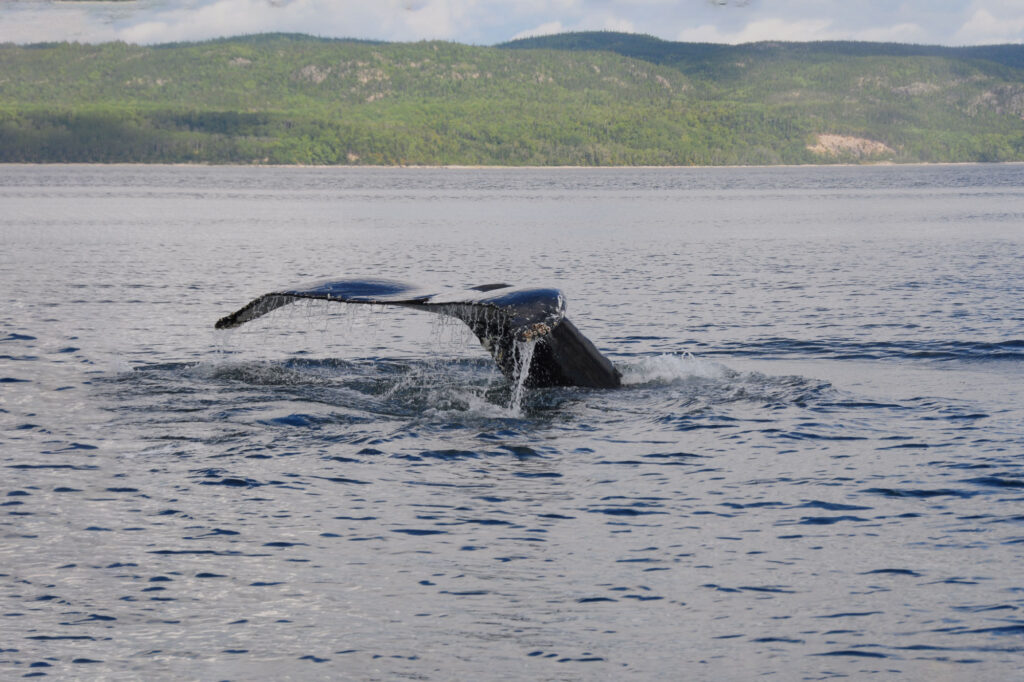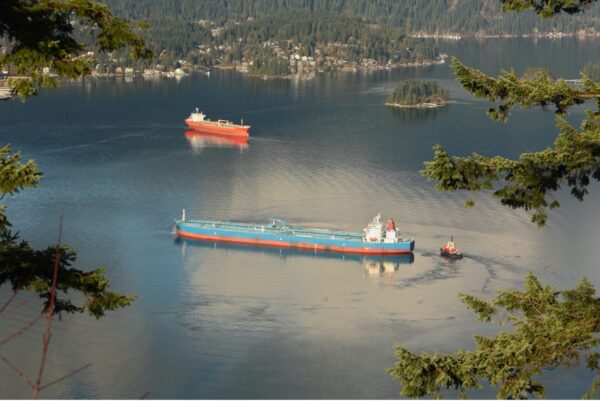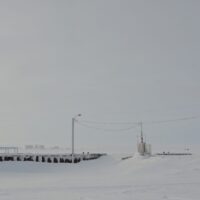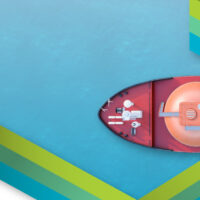The Marine Acoustic Research Station (MARS) project aims to measure the acoustic signature of vessels transiting the St. Lawrence River to help manage the effect of ship noise on marine mammals.
Sylvain Lafrance has been active in the maritime sector for more than 30 years. He started his career as a researcher in the field of fisheries, notably in West Africa. For the last 25 years, he has headed organizations involved in both economic development and applied research. Mr. Lafrance holds a Bachelor’s degree in Science and a Master’s degree in Marine Resource Management, and has held the role of Executive Director at Innovation maritime since 2013.
Based in Rimouski and active since 2001, Innovation maritime is an applied research centre affiliated with the Quebec Maritime Institute (IMQ) that seeks to contribute to the development of the marine sector through innovation. Its areas of activity are marine engineering, environmental technologies, marine intelligence, marine transport and navigation, and underwater intervention. The organization employs 30 individuals actively involved in applied research.
Interview
What is the MARS (Marine Acoustic Research Station) project?
MARS is an applied research project initiated by the Université du Québec à Rimouski (UQAR), the Institut des sciences de la mer de Rimouski (ISMER) and Innovation maritime (IMAR), with support from the electronics company Multi-Électronique (MTE) and OpDAQ Systems, a company specializing in ship-board instrumentation systems. The project entails implementing and operating a world-class marine acoustic research station in the St. Lawrence River – in the centre of the Laurentian Channel – offshore from Rimouski. Known for the abundance and diversity of the marine mammals inhabiting it, this zone has a number of characteristics conducive to establishing the research station (bathymetry, weak current, etc.).
These features and the configuration of the moorings envisioned for the station will allow the acoustic signature of vessels transiting the St. Lawrence to be measured in keeping with internationally recognized standards. To our knowledge, no such station exists anywhere else in the world. Its unique nature will allow Quebec to stand out in terms of acoustic research, while providing practical answers with regard to mitigation measures that could be implemented to reduce the impact of vessel noise on marine mammals.

Photo credit: Éric Perreault, Innovation maritime
MARS brings together a number of research bodies and companies who wish to improve their environmental impact. The project has received the support of various organizations interested in the harmonious cohabitation of marine transport and marine mammals. Ship operators associated with the project include Canada Steamship Lines, Desgagnés, Fednav and Algoma. Two Rimouski-based companies active in the maritime sector – OpDAQ Systems and Multi-Électronique – are also partners. The MARS project is currently underway and will run until March 2024. It has received funding from Transport Canada, Quebec’s Ministry of Economic Development and Innovation and private partners.
Where did the idea to learn more about the impacts of underwater noise come from, and what steps had to be taken with ship operators to make the project possible?
We know that vessel noise significantly affects marine mammals, which use sounds to communicate with one another (between mother and calf) and to feed (search for prey). Many studies have been conducted to better understand the impact of noise on marine mammals, especially anthropogenic noise, like those generated by ships. However, there are fewer studies on the noise footprint from vessels, sources of noise from ships and mitigation measures. In 2017, Innovation maritime joined private partners to propose an initial large-scale project on vessel acoustics and the implementation of a research station in the St. Lawrence River. Unfortunately, this project did not receive funding at the time. During a workshop on underwater noise pollution held in 2018 by MeRLIN (Technopole maritime du Québec), the idea of setting up a research station was revived.
The workshop provided the momentum required to engage several partners and define the project’s goals and steps. Since 2018, we have been working in close collaboration with ISMER and private partners to hone the methodology and secure necessary funding. The involvement of Canada Steamship Lines, Desgagnés, Fednav and Algoma allowed us to take ship operators’ needs into account and to highlight the project’s importance for the Quebec Ministry of Economic Development and Innovation and Transport Canada. Support from SODES, Green Marine as well as from the Montreal, Quebec, Trois-Rivières and Saguenay port authorities also helped move the project forward. Over the past three years, the MARS project has required considerable work on the part of our organization and our partners, and we are pleased to be moving into the implementation phase.
What work will be carried out and what will be the spinoffs for the maritime industry?
The project has two main goals. First, under ISMER’s lead, it seeks to measure the noise levels of vessels transiting the St. Lawrence in keeping with international standards. Second, under IMAR’s lead, the project aims to link vessel noise levels to their operating conditions and the noise-generating elements on board ships to assess and develop mitigation measures. OpDAQ Systems and Multi-Électronique will help with vessel instrumentation and the deployment of measurement tools in deep water.
The project will make information available to ship operators so they can take action with regard to the underwater noise generated by their vessels. Simply put, the project’s four main components include:
- Measuring the vessels’ acoustic signature
- Identifying noise sources and mapping the pathways for transmitting noise on board ships
- Developing autonomous instrumentation for continuous noise measurement
- Assessing the impact of mitigation measures
Numerous results are expected for ship operators and the companies associated with the project, including:
- Detailed diagnoses of noise sources on board ships (for the vessels used as measuring platforms)
- A proven tool for continuous measurement of noise on board ships
- Vessel-specific measurements of at-source noise levels in keeping with international standards
- Analyses of mitigation measures that can be implemented to reduce vessel noise
The outcomes of the MARS project will be significant, tangible, and, above all, quickly available to both our partners and government stakeholders. In addition to the spinoffs for the industry, the project will allow Quebec to develop a solid expertise in acoustics applicable to the maritime sector. It will also enable new research collaboration between Quebec and France since the MARS team will work closely with the team of the PIAQUO project, a major European research initiative targeting acoustics in the maritime sector.
Will all ship operators operating on the St. Lawrence be able to benefit from the work done in the context of the MARS project?
Four ship operators – Fednav, Algoma, Desgagnés and Canada Steamship Lines – are associated with the project. They will be involved in funding, use their expertise to guide the project and, when needed, will make their vessels available for project requirements. We will be working closely with these four ship operators and the reports produced, affecting their vessels directly, will be submitted to them confidentially. These reports could take the form of customized technical sheets on their vessels’ acoustic signature or technical diagnoses of noise and vibrations on board ships.
The team also plans to produce more global technical reports presenting the project findings. These reports will cover numerous subjects and will be developed for both financial partners and maritime community stakeholders. All ship operators will be able to look through the project findings.
It is also important to create a database of vessel acoustic signatures. The signatures of our partnering ship operators will not be sufficient to provide the depth of data we would like to have for research purposes. Consequently, we would also like to collaborate with other domestic ship operators interested in getting information on their vessels’ acoustic footprint. It is likely that this could take place in the fall of 2021 or in 2022. Subsequently, we will also determine whether there is an interest on the part of foreign ship operators. The terms of such collaborations remain to be defined.

Sylvain Lafrance, Executive Director
Innovation maritime
Learn more
Underwater noise and marine mammals
Marine shipping on the St. Lawrence
#underwaternoise #marinemammals #sustainablemarineshipping



